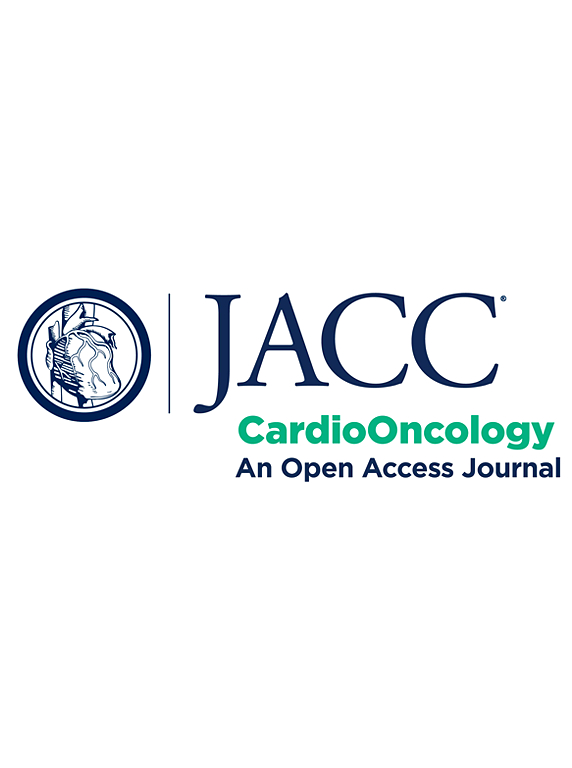Cardiac Effects of Modern Breast Radiation Therapy in Patients Receiving Systemic Cancer Therapy
IF 12.8
1区 医学
Q1 CARDIAC & CARDIOVASCULAR SYSTEMS
引用次数: 0
Abstract
Background
Radiation therapy (RT) improves breast cancer outcomes, but cardiac morbidity remains a concern.
Objectives
This study sought to evaluate changes in cardiac function after RT and the relationship between cardiac dose metrics and echocardiography-derived measures of function.
Methods
In a longitudinal cohort study of women with breast cancer, radiation cardiac dose metrics and core lab quantitated echocardiographic measures of cardiac function were evaluated. Dose metrics included the whole heart, left ventricle, right ventricle, and left anterior descending artery (LAD). Echocardiographic measures included left ventricular ejection fraction (LVEF), longitudinal strain, circumferential strain, E/e’ (ratio of early diastolic mitral inflow velocity to early diastolic mitral annular tissue velocity), Ea/Es (ventricular arterial coupling; ratio of effective arterial elastance to end systolic elastance), and right ventricular fractional area change. The mean change in echocardiographic measures over time and the association between cardiac dose metrics and echocardiographic measures were estimated by repeated-measures multivariable linear regression via generalized estimating equations.
Results
The cohort included 303 participants (median age 52 years, 33.3% African American) who received adjuvant RT (2010-2019) with a median mean heart dose of 1.19 Gy (Q1-Q3: 0.75-2.61 Gy), were followed over a median of 5.1 years (Q1-Q3: 3.2-7.1 years). Across all participants, there was a modest increase in LVEF (52.1% pre-RT to 54.3% at 5 years; P < 0.001) but a worsening in sensitive measures of function, such as circumferential strain (−23.7% pre-RT to −21.0% at 5 years; P = 0.003). Among left-sided/bilateral breast cancer participants, changes in cardiac function were observed across all parameters (P < 0.05). The maximum LAD dose was associated with a modest worsening in LVEF, longitudinal strain, circumferential strain, and E/e′.
Conclusions
Over a median of 5.1 years, modest changes in cardiac function were observed with RT. Maximum LAD dose was associated with a worsening in systolic and diastolic function parameters.
现代乳房放射治疗对接受全身癌症治疗的患者心脏的影响。
背景:放射治疗(RT)改善了乳腺癌的预后,但心脏发病率仍然是一个问题。目的:本研究旨在评估RT后心功能的变化,以及心脏剂量指标与超声心动图衍生的功能测量之间的关系。方法:在一项对乳腺癌妇女的纵向队列研究中,对心脏辐射剂量指标和核心实验室定量超声心动图心功能指标进行了评估。剂量指标包括整个心脏、左心室、右心室和左前降支(LAD)。超声心动图测量包括左室射血分数(LVEF)、纵向应变、周向应变、E/ E′(舒张早期二尖瓣流入速度与舒张早期二尖瓣环组织速度之比)、Ea/Es(心室动脉耦合;有效动脉弹性与收缩末期弹性之比)及右心室面积变化。超声心动图测量值随时间的平均变化以及心脏剂量测量值与超声心动图测量值之间的相关性通过广义估计方程通过重复测量多变量线性回归估计。结果:该队列包括303名参与者(中位年龄52岁,33.3%非裔美国人),他们接受了辅助放疗(2010-2019),平均心脏剂量中位数为1.19 Gy (Q1-Q3: 0.75-2.61 Gy),随访中位数为5.1年(Q1-Q3: 3.2-7.1年)。在所有参与者中,LVEF略有增加(放疗前为52.1%,5年时为54.3%;P < 0.001),但功能敏感指标恶化,如周向应变(放疗前-23.7%至5年-21.0%;P = 0.003)。在左侧/双侧乳腺癌患者中,所有参数均观察到心功能的变化(P < 0.05)。最大LAD剂量与LVEF、纵向应变、周向应变和E/ E′的适度恶化相关。结论:在中位5.1年的时间里,rt观察到心脏功能的适度变化。最大剂量的LAD与收缩和舒张功能参数的恶化有关。
本文章由计算机程序翻译,如有差异,请以英文原文为准。
求助全文
约1分钟内获得全文
求助全文
来源期刊

Jacc: Cardiooncology
Multiple-
CiteScore
12.50
自引率
6.30%
发文量
106
期刊介绍:
JACC: CardioOncology is a specialized journal that belongs to the esteemed Journal of the American College of Cardiology (JACC) family. Its purpose is to enhance cardiovascular care for cancer patients by publishing high-quality, innovative scientific research and sharing evidence-based knowledge.
The journal aims to revolutionize the field of cardio-oncology and actively involve and educate professionals in both cardiovascular and oncology fields. It covers a wide range of topics including pre-clinical, translational, and clinical research, as well as best practices in cardio-oncology. Key areas of focus include understanding disease mechanisms, utilizing in vitro and in vivo models, exploring novel and traditional therapeutics (across Phase I-IV trials), studying epidemiology, employing precision medicine, and investigating primary and secondary prevention.
Amyloidosis, cardiovascular risk factors, heart failure, and vascular disease are some examples of the disease states that are of particular interest to the journal. However, it welcomes research on other relevant conditions as well.
 求助内容:
求助内容: 应助结果提醒方式:
应助结果提醒方式:


